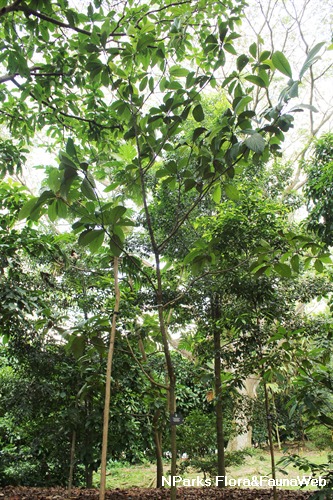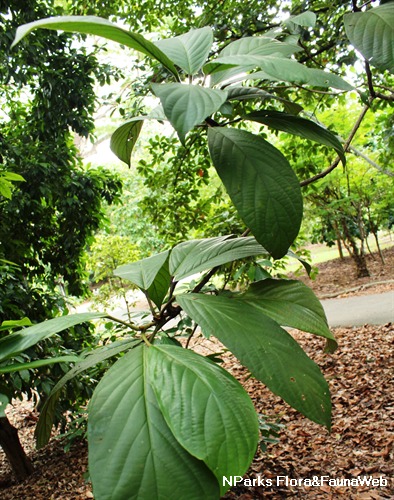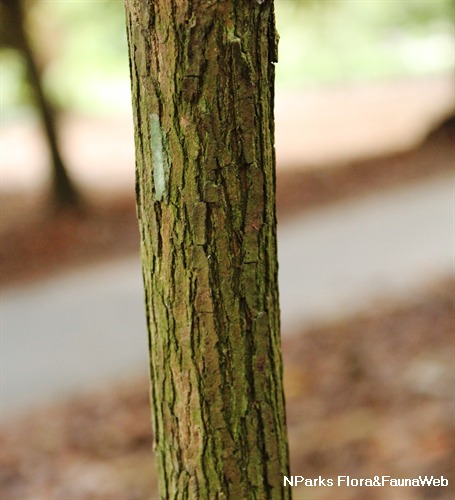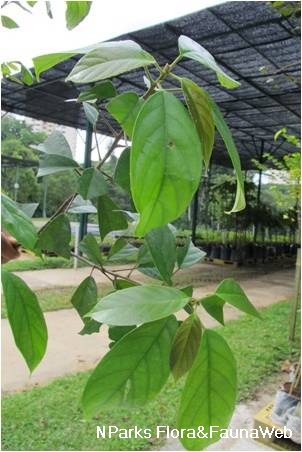
Name
Classifications and Characteristics
| Plant Growth Form | Tree (Medium (16m-30m)) |
|---|---|
| Lifespan (in Singapore) | Perennial |
Biogeography
| Native Distribution | Sumatra, Peninsular Malaysia, Singapore, and Borneo |
|---|---|
| Native Habitat | Terrestrial |
| Preferred Climate Zone | Tropical |
| Local Conservation Status | Native to Singapore (Critically Endangered (CR)) |
Description and Ethnobotany
| Growth Form | It is a shrub, or small tree up to 18 m tall with a slender crown. |
|---|---|
| Trunk | Bark is fissured and finely ridged. |
| Foliage | Its alternate, long-stalked leaves have papery leaf blades that are oval to drop-shaped, finely velvety below, and 15–36 by 6.2–14 cm, with tapered bases. |
| Flowers | Its male flowers are yellowish-green, 1.5–3 mm wide, and found in clusters up to 18 cm long. Its female flowering clusters have pink branches, are up to 23 cm long, and bear 5–7 mm-wide female flowers. |
| Fruit | Its round fruits are 10–19 mm-wide berries found in hanging strings up to 30 cm long from the trunk. They also ripen from waxy white to rose-pink, and contain one to three seeds embedded in blue pulp. Its ovoid seeds are laterally flattened, and 6–8 mm wide. |
| Habitat | It grows in primary and secondary rainforests on sandy loam, and seasonal swamp forests, up to 700 m altitude. It occurs locally in Bukit Timah Nature Reserve. |
| Associated Fauna | Its flowers are insect-pollinated. Its fruits are consumed by mammals which disperse the seeds. |
| Cultivation | It can be propagated by seed. |
| Etymology | Latin bacca, berry; Latin aurea, golden, so named from the golden colour of the berries; Latin brevis, short; Latin pes, a foot, the reference to which is unsure |
| Ethnobotanical Uses | Edible Plant Parts : Edible Fruits Food (Fruit or Vegetable) Others: The fruit is edible but insipid. The wood is used in house building but is not resistant to insects. An extract of the leaves is used to regulate menstruation. |
Landscaping Features
| Landscape Uses | Suitable for Roadsides, Parks & Gardens |
|---|
Plant Care and Propagation
| Light Preference | Full Sun |
|---|---|
| Water Preference | Lots of Water, Moderate Water, Little Water |
| Plant Growth Rate | Moderate |
| Rootzone Tolerance | Drought Tolerant, Moist Soils, Fertile Loamy Soils |
| Propagation Method | Seed |
Foliar
| Mature Foliage Texture(s) | Papery |
|---|
Floral (Angiosperm)
| Flower Colour(s) | Green - Light Green |
|---|
Fruit, Seed and Spore
| Mature Fruit Colour(s) | Pink |
|---|
Image Repository
Others
| Master ID | 29692 |
|---|---|
| Species ID | 4001 |
| Flora Disclaimer | The information in this website has been compiled from reliable sources, such as reference works on medicinal plants. It is not a substitute for medical advice or treatment and NParks does not purport to provide any medical advice. Readers should always consult his/her physician before using or consuming a plant for medicinal purposes. |








